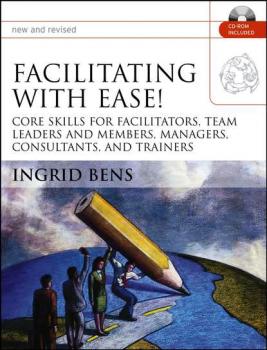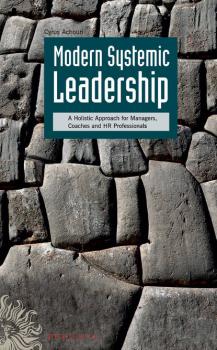ТОП просматриваемых книг сайта:
Зарубежная деловая литература
Различные книги в жанре Зарубежная деловая литература, доступные для чтения и скачиванияАннотация
Facilitating with Ease! is an updated version of the best-selling resource that offers easy-to-follow instructions, techniques, and hands-on tools that team leaders, consultants, supervisors, and managers have used to learn the basics of facilitation. Complete with worksheets on CD-ROM that can be customized to fit your personal needs, it's a complete facilitation workshop in a take-home format. Facilitating with Ease! shows you how to run productive meetings with skill and authority and includes the information needed to train others in your organization to become confident facilitators as well. The book is filled with dozens of exercises, surveys, and checklists that can be used to transform anyone into an effective facilitator.
Аннотация
Use scrum in all aspects of life Scrum is an agile project management framework that allows for flexibility and collaboration to be a part of your workflow. Primarily used by software developers, scrum can be used across many job functions and industries. Scrum can also be used in your personal life to help you plan for retirement, a trip, or even a wedding or other big event. Scrum provides a small set of rules that create just enough structure for teams to be able to focus their innovation on solving what might otherwise be an insurmountable challenge. Scrum For Dummies shows you how to assemble a scrum taskforce and use it to implement this popular Agile methodology to make projects in your professional and personal life run more smoothly—from start to finish. Discover what scrum offers project and product teams Integrate scrum into your agile project management strategy Plan your retirement or a family reunion using scrum Prioritize for releases with sprints No matter your career path or job title, the principles of scrum are designed to make your life easier. Why not give it a try?
Аннотация
Quantitative analysis of outcomes vs PMs at the individual level Leading Complex Projects takes a unique approach to post-mortem analysis to provide project managers with invaluable insight. For the first time, individual PM characteristics are quantitatively linked to project outcomes through a major study investigating the role of project leadership in the success and failure of complex industrial projects; hard data on the backgrounds, education, and personality characteristics of over 100 directors of complex projects is analyzed against the backdrop of project performance to provide insight into controllable determinants of outcomes. By placing these analyses alongside their own data, PMs will gain greater insight into areas of weakness and strength, locate recurring obstacles, and identify project components in need of greater planning, oversight, or control. The role of leadership is to deliver results; in project management, this means taking responsibility for project outcomes. PMs are driven by continuous improvement, and this book provides a wealth of insight to help you achieve the next step forward. Understand why small, simple projects consistently outperform larger, more complex projects Delve into the project manager's role in generating successful outcomes Examine the data from over 100 PMs of complex industrial projects Link PM characteristics to project outcome to find areas for improvement Complex industrial projects from around the world provide a solid basis for quantitative analysis of outcomes—and the PMs who drive them. Although the majority of the data is taken from projects in the petroleum industry, the insights gleaned from analysis are widely applicable across industry lines for PMs who lead complex projects of any stripe. Leading Complex Projects provides clear, data-backed improvement guidance for anyone in a project management role.
Аннотация
Project Portfolio Management (PPM) goes beyond the typical project management approach to offer a set of proven business practices that can help executives, program managers, and project managers bring projects into alignment with the strategies, resources, and executive oversight of the overall enterprise. Step by step, this book shows how to take a project from the inception of a vision to the realization of benefits to the organization. Project Portfolio Management draws on project management expert Harvey A. Levine’s years of research and distills the knowledge and best practices from dozens of leaders in the field to show how to select and implement the projects that will garner the best results. Throughout this important resource, Levine tackles the many challenges associated with PPM, including Ranking value and benefits Determining the size of the portfolio pipeline Assessing the impact of uncertainty on projects and portfolios Understanding the benefit and risk relationship Establishing a portfolio governance capability Managing the portfolio to maximize benefits Implementing PPM
Аннотация
Museums After Modernism is a unique collectionthat showcases the ways questions about the museum go to the heart of contemporary debates about the production, consumption and distribution of art. The book features expert artists, curators and art historians who grapple with many of the vibrant issues in museum studies, while paying homage to a new museology that needs to be considered. Examines the key contemporary debates in museum studies Includes original essays by noted artists, curators, and art historians Engages with vital issues in the practice of art-making and art-exhibiting Edited by the world-renowned art historian and author, Griselda Pollock
Аннотация
Buying For Business provides a simple but comprehensive guide to purchasing and supply. With current literature often academic in focus and unsuited to modern business readers, it offers straightforward and engaging information on the principles and practice of purchasing and supply management that will be of great value to anyone in business who deals with suppliers. Experts Mark Whitehead and Christopher Barrat answer all the key questions facing purchasing in business today, and offer advice on everything from ethics to outsourcing. Diagrams, analysis tools and pro-formas aid understanding, while case studies and bench-marking exercises illustrate and reinforce the learning.
Аннотация
This book supports a turn in the leadership paradigm: from environment to system, from manager to employee. It offers an introduction to essential managerial instruments for the improvement of Performance, like Staff Dialogue, Upward Feedback, Executive Coaching, or Business Ethics. Different leadership styles and techniques are explained as well as international and intercultural dimensions of Human Resources Management. Furthermore an innovative approach is developed to utilize System Theory and its interdisciplinary results in evolutionism, biology, physics, philosophy, cognition science and therapy for the design of Systemic Leadership. By this approach, readers will achieve a higher level of comprehension of how leadership actions may affect – or why they do not affect – the behavior of individuals or groups in enterprises and organizations. The book is intended – as a source of new ideas and creative proposals for Executives and Personnel Managers who, in their enterprises, want to put into practice an Extended Catalogue of Management Tools, and – for Students to accompany lectures in Business Administration with focus on Personnel Management. «In today's complex business environment, we urgently need a systemic approach to management and leadership. Cyrus Achouri's book is an important contribution to this new field. I am sure that readers seeking a deeper understanding of leadership will find it helpful and inspiring.» Fritjof Capra, author of «The Web of Life» and «The Hidden Connections»
Аннотация
This book provides you with the means to set development goals and to track your progress on achieving them. It can help you efficiently gather and make sense of information about your progress and avoid common pitfalls that can block your development. Tracking your development can be captures in a few steps: articulating your goal, creating an action plan, gathering information about your behavior, indentifying barriers and support, and revising your action plan. Taking these steps will greatly increase the likelihood of achieving your goals.
Аннотация
Leadership is best learned from experience, but learning from experience is not always automatic. This guidebook introduces you to a return-on-experience framework. Using this ROE framework, you actively seek to learn from experience in order to build your mastery, broaden your versatility, and benefit your organization. When you understand and apply the framework in your work and organization, everyday experiences can be transformed into an engine for leader development and organizational impact.
Аннотация
Traditional forms of collaboration are not sufficient for competing effectively in the more complex and dynamic environment of today’s business world. Face-to-face meetings between people of similar backgrounds have given way to increasingly complex working relationships. Organizations must be able to gain rapid access to knowledgeable people to meet constantly changing conditions and demands. More fluid, flexible, and easily reconfigurable collaborative relationships are necessary to produce the innovations that can make or break organizations¾even entire industries¾ and provide the opportunities that attract the talented and motivated employees who will make the difference between success and failure. Business Without Boundaries helps managers address these challenges. The authors explore a number of wide-ranging, real-world cases to identify hands-on principles for successful collaboration. They offer managers and executives practical steps and tools for creating, facilitating, and supporting complex collaborations throughout their organizations. And they explain how to “team” across boundaries in the new global economy. The recommendations are specific enough to apply to particular forms of complex collaboration (for example supply chains, global product development teams, interorganizational alliances) but general enough to apply to new forms that have yet to emerge.










